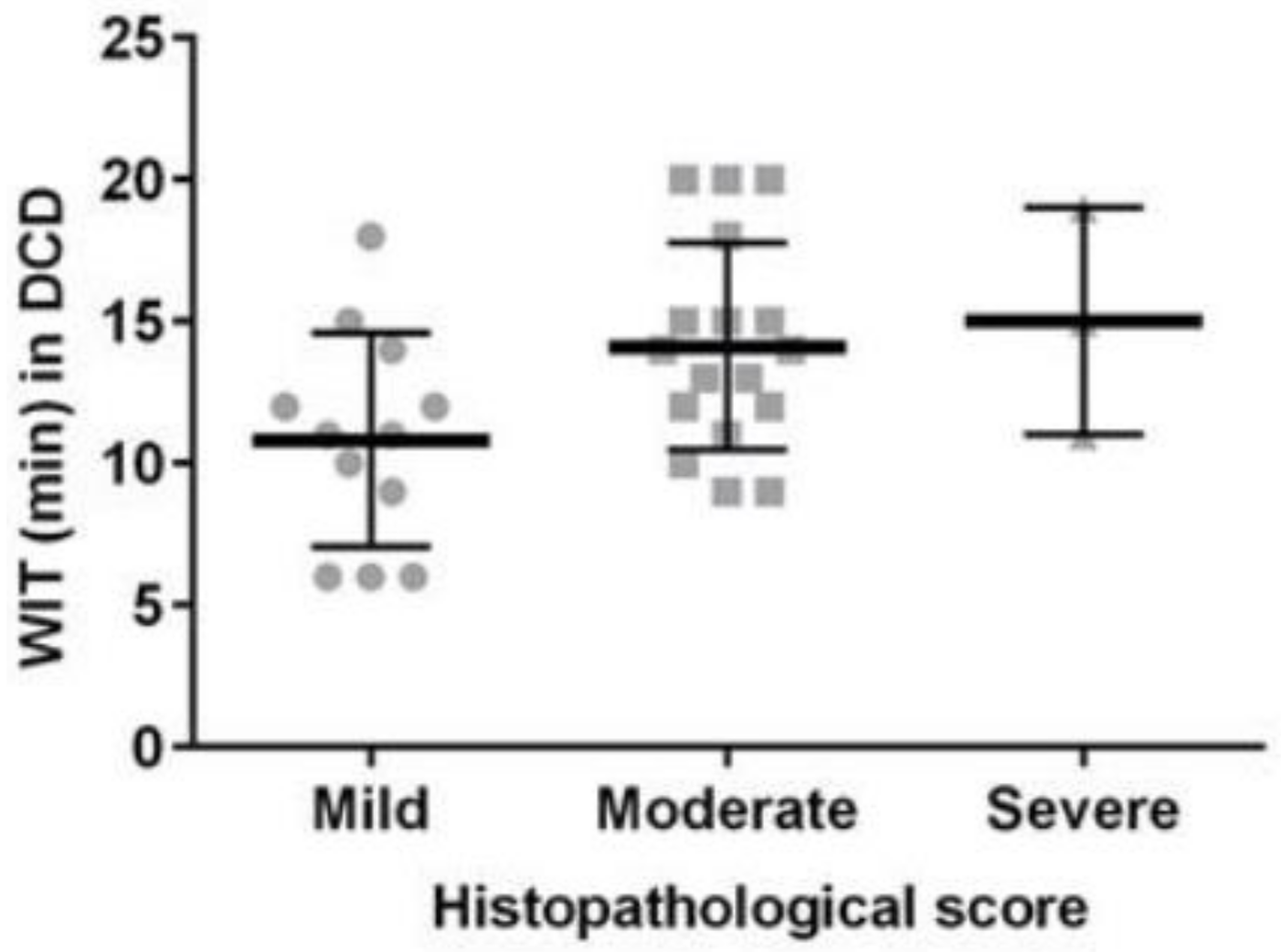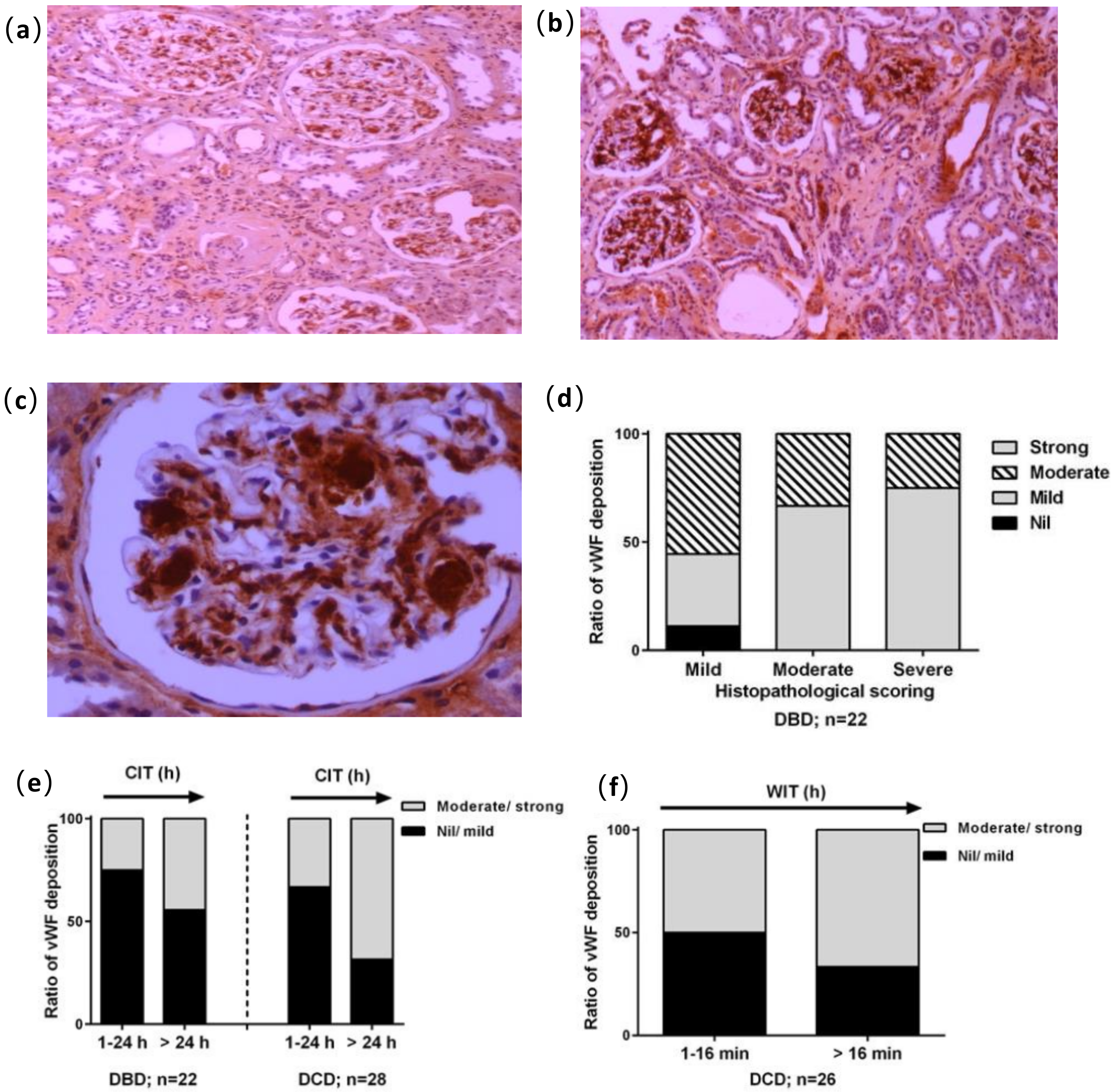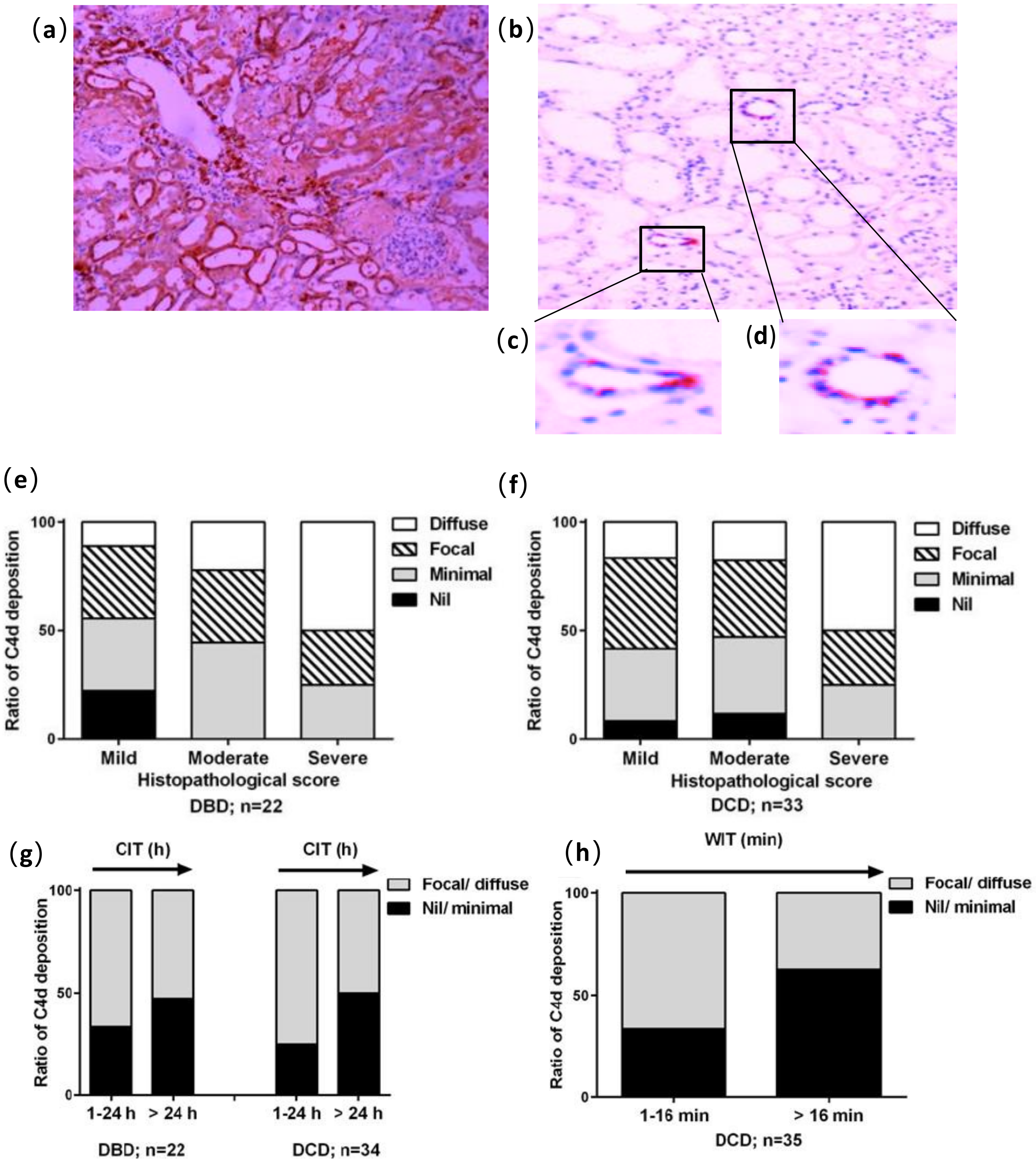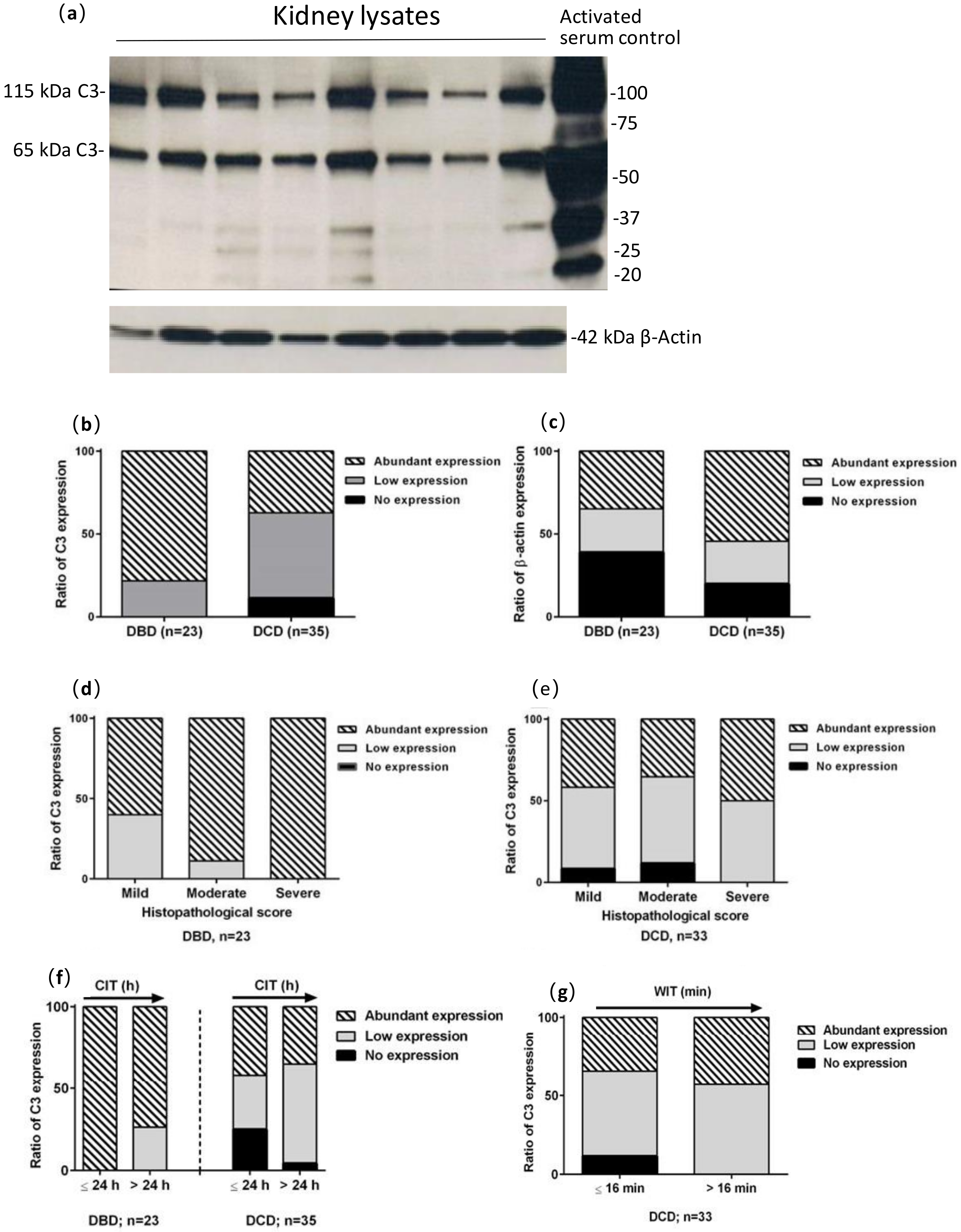Comparative Analysis of Risk Factors in Declined Kidneys from Donation after Brain Death and Circulatory Death
Abstract
1. Introduction
2. Materials and Methods
2.1. Ethics
2.2. Histological Evaluation
2.3. Myeloperoxidase Activity
2.4. Glomerular Accumulation of vWF Reactivity
2.5. Epithelial Deposition of C4d
2.6. Complement 3 in Kidney Lysates
2.7. Statistics
3. Results
3.1. Description of Donated Kidneys
3.2. Histology and Inflammation
3.3. Glomerular Accumulation of vWF Reactivity
3.4. Epithelial Deposition of C4d, A Marker of Complement Activation
3.5. Complement C3 and β-Actin in Kidney Lysates
4. Discussion
5. Conclusions
Author Contributions
Funding
Acknowledgments
Conflicts of Interest
References
- Johnson, R.J.; Bradbury, L.L.; Martin, K.; Neuberger, J.; Registry, U.K.T. Organ donation and transplantation in the UK-the last decade: A report from the UK national transplant registry. Transplantation 2014, 97 (Suppl. 1), S1–S27. [Google Scholar] [CrossRef]
- Callaghan, C.J.; Harper, S.J.; Saeb-Parsy, K.; Hudson, A.; Gibbs, P.; Watson, C.J.; Praseedom, R.K.; Butler, A.J.; Pettigrew, G.J.; Bradley, J.A. The discard of deceased donor kidneys in the UK. Clin. Transplant. 2014, 28, 345–353. [Google Scholar] [CrossRef] [PubMed]
- Dare, A.J.; Pettigrew, G.J.; Saeb-Parsy, K. Preoperative assessment of the deceased-donor kidney: From macroscopic appearance to molecular biomarkers. Transplantation 2014, 97, 797–807. [Google Scholar] [CrossRef] [PubMed]
- Nagaraja, P.; Roberts, G.W.; Stephens, M.; Horvath, S.; Fialova, J.; Chavez, R.; Asderakis, A.; Kaposztas, Z. Influence of delayed graft function and acute rejection on outcomes after kidney transplantation from donors after cardiac death. Transplantation 2012, 94, 1218–1223. [Google Scholar] [CrossRef] [PubMed]
- Siedlecki, A.; Irish, W.; Brennan, D.C. Delayed graft function in the kidney transplant. Am. J. Transpl. 2011, 11, 2279–2296. [Google Scholar] [CrossRef] [PubMed]
- Summers, D.M.; Johnson, R.J.; Allen, J.; Fuggle, S.V.; Collett, D.; Watson, C.J.; Bradley, J.A. Analysis of factors that affect outcome after transplantation of kidneys donated after cardiac death in the UK: A cohort study. Lancet 2010, 376, 1303–1311. [Google Scholar] [CrossRef]
- Perico, N.; Cattaneo, D.; Sayegh, M.H.; Remuzzi, G. Delayed graft function in kidney transplantation. Lancet 2004, 364, 1814–1827. [Google Scholar] [CrossRef]
- Morrissey, P.E.; Monaco, A.P. Donation after circulatory death: Current practices, ongoing challenges, and potential improvements. Transplantation 2014, 97, 258–264. [Google Scholar] [CrossRef]
- Wadei, H.M.; Heckman, M.G.; Rawal, B.; Taner, C.B.; Farahat, W.; Nur, L.; Mai, M.L.; Prendergast, M.; Gonwa, T.A. Comparison of kidney function between donation after cardiac death and donation after brain death kidney transplantation. Transplantation 2013, 96, 274–281. [Google Scholar] [CrossRef]
- Summers, D.M.; Johnson, R.J.; Hudson, A.; Collett, D.; Watson, C.J.; Bradley, J.A. Effect of donor age and cold storage time on outcome in recipients of kidneys donated after circulatory death in the UK: A cohort study. Lancet 2013, 381, 727–734. [Google Scholar] [CrossRef]
- Correa, S.; Pena-Esparragoza, J.K.; Scovner, K.M.; Waikar, S.S.; Mc Causland, F.R. Myeloperoxidase and the Risk of CKD Progression, Cardiovascular Disease, and Death in the Chronic Renal Insufficiency Cohort (CRIC) Study. Am. J. Kidney Dis. 2019. [Google Scholar] [CrossRef] [PubMed]
- Fu, Z.; Ye, Q.; Zhang, Y.; Zhong, Z.; Xiong, Y.; Wang, Y.; Hu, L.; Wang, W.; Huang, W.; Ko, D.S. Hypothermic Machine Perfusion Reduced Inflammatory Reaction by Downregulating the Expression of Matrix Metalloproteinase 9 in a Reperfusion Model of Donation After Cardiac Death. Artif. Organs 2016, 40, E102–E111. [Google Scholar] [CrossRef] [PubMed]
- Yang, B.; Hosgood, S.A.; Harper, S.J.; Nicholson, M.L. Leucocyte depletion improves renal function in porcine kidney hemoreperfusion through reduction of myeloperoxidase+ cells, caspase-3, IL-1beta, and tubular apoptosis. J. Surg. Res. 2010, 164, e315–e324. [Google Scholar] [CrossRef] [PubMed]
- Kennedy, C.; Wong, L.; Sexton, D.J.; Cowman, J.; Oglesby, I.; Kenny, M.; Conlon, P.J.; Kenny, D. Successful kidney transplantation normalizes platelet function. Clin. Kidney J. 2018, 11, 574–580. [Google Scholar] [CrossRef] [PubMed]
- Damman, J.; Nijboer, W.N.; Schuurs, T.A.; Leuvenink, H.G.; Morariu, A.M.; Tullius, S.G.; van Goor, H.; Ploeg, R.J.; Seelen, M.A. Local renal complement C3 induction by donor brain death is associated with reduced renal allograft function after transplantation. Nephrol. Dial. Transpl. Off. Publ. Eur. Dial. Transpl. Assoc. Eur. Ren. Assoc. 2011, 26, 2345–2354. [Google Scholar] [CrossRef]
- Yu, W.; Sheng, M.; Xu, R.; Yu, J.; Cui, K.; Tong, J.; Shi, L.; Ren, H.; Du, H. Berberine protects human renal proximal tubular cells from hypoxia/reoxygenation injury via inhibiting endoplasmic reticulum and mitochondrial stress pathways. J. Transl. Med. 2013, 11, 24. [Google Scholar] [CrossRef]
- Zwaini, Z.; Dai, H.; Stover, C.; Yang, B. Role of Complement Properdin in Renal Ischemia-Reperfusion Injury. Curr. Gene 2018. [Google Scholar] [CrossRef]
- Damman, J.; Schuurs, T.A.; Ploeg, R.J.; Seelen, M.A. Complement and renal transplantation: From donor to recipient. Transplantation 2008, 85, 923–927. [Google Scholar] [CrossRef]
- Xu, H.; He, X.; Sun, J.; Shi, D.; Zhu, Y.; Zhang, X. The expression of B-cell activating factor belonging to tumor necrosis factor superfamily (BAFF) significantly correlated with C4D in kidney allograft rejection. Transpl. Proc. 2009, 41, 112–116. [Google Scholar] [CrossRef]
- Maeng, Y.I.; Kim, M.K.; Park, J.B.; Cho, C.H.; Oh, H.K.; Sung, W.J.; Park, K.K. Glomerular and tubular C4d depositions in IgA nephropathy: Relations with histopathology and with albuminuria. Int. J. Clin. Exp. Pathol. 2013, 6, 904–910. [Google Scholar]
- Remuzzi, G.; Cravedi, P.; Perna, A.; Dimitrov, B.D.; Turturro, M.; Locatelli, G.; Rigotti, P.; Baldan, N.; Beatini, M.; Valente, U.; et al. Long-term outcome of renal transplantation from older donors. N. Engl. J. Med. 2006, 354, 343–352. [Google Scholar] [CrossRef] [PubMed]
- Pusztaszeri, M.P.; Seelentag, W.; Bosman, F.T. Immunohistochemical expression of endothelial markers CD31, CD34, von Willebrand factor, and Fli-1 in normal human tissues. J. Histochem. Cytochem. 2006, 54, 385–395. [Google Scholar] [CrossRef] [PubMed]
- Snoeijs, M.G.; Dekkers, A.J.; Buurman, W.A.; van den Akker, L.; Welten, R.J.; Schurink, G.W.; van Heurn, L.W. In situ preservation of kidneys from donors after cardiac death: Results and complications. Ann. Surg. 2007, 246, 844–852. [Google Scholar] [CrossRef]
- Gok, M.A.; Bhatti, A.A.; Asher, J.; Gupta, A.; Shenton, B.K.; Robertson, H.; Soomro, N.A.; Talbot, D. The effect of inadequate in situ perfusion in the non heart-beating donor. Transpl. Int. 2005, 18, 1142–1146. [Google Scholar] [CrossRef] [PubMed]
- Molnar, M.Z.; Streja, E.; Kovesdy, C.P.; Shah, A.; Huang, E.; Bunnapradist, S.; Krishnan, M.; Kopple, J.D.; Kalantar-Zadeh, K. Age and the associations of living donor and expanded criteria donor kidneys with kidney transplant outcomes. Am. J. Kidney Dis. 2012, 59, 841–848. [Google Scholar] [CrossRef]
- Veroux, M.; Grosso, G.; Corona, D.; Mistretta, A.; Giaquinta, A.; Giuffrida, G.; Sinagra, N.; Veroux, P. Age is an important predictor of kidney transplantation outcome. Nephrol. Dial. Transpl. Off. Publ. Eur. Dial. Transpl. Assoc. Eur. Ren. Assoc. 2012, 27, 1663–1671. [Google Scholar] [CrossRef]
- Akoh, J.A.; Rana, T.A. Impact of donor age on outcome of kidney transplantation from controlled donation after cardiac death. Saudi J. Kidney Dis. Transpl. 2013, 24, 673–681. [Google Scholar] [CrossRef]
- Quiroga, I.; McShane, P.; Koo, D.D.; Gray, D.; Friend, P.J.; Fuggle, S.; Darby, C. Major effects of delayed graft function and cold ischaemia time on renal allograft survival. Nephrol. Dial. Transpl. Off. Publ. Eur. Dial. Transpl. Assoc. Eur. Ren. Assoc. 2006, 21, 1689–1696. [Google Scholar] [CrossRef]
- Kim, S.M.; Ahn, S.; Min, S.I.; Park, D.; Park, T.; Min, S.K.; Kim, S.J.; Ha, J. Cold ischemic time is critical in outcomes of expanded criteria donor renal transplantation. Clin. Transplant. 2013, 27, 132–139. [Google Scholar] [CrossRef]
- Kayler, L.K.; Magliocca, J.; Zendejas, I.; Srinivas, T.R.; Schold, J.D. Impact of cold ischemia time on graft survival among ECD transplant recipients: A paired kidney analysis. Am. J. Transpl. 2011, 11, 2647–2656. [Google Scholar] [CrossRef]
- De Vries, D.K.; van der Pol, P.; van Anken, G.E.; van Gijlswijk, D.J.; Damman, J.; Lindeman, J.H.; Reinders, M.E.; Schaapherder, A.F.; Kooten, C. Acute but transient release of terminal complement complex after reperfusion in clinical kidney transplantation. Transplantation 2013, 95, 816–820. [Google Scholar] [CrossRef] [PubMed]
- Naesens, M.; Li, L.; Ying, L.; Sansanwal, P.; Sigdel, T.K.; Hsieh, S.C.; Kambham, N.; Lerut, E.; Salvatierra, O.; Butte, A.J.; et al. Expression of complement components differs between kidney allografts from living and deceased donors. J. Am. Soc. Nephrol. 2009, 20, 1839–1851. [Google Scholar] [CrossRef] [PubMed]
- Damman, J.; Daha, M.R.; Leuvenink, H.G.; van Goor, H.; Hillebrands, J.L.; Dijk, M.C.; Hepkema, B.G.; Snieder, H.; Born, J.; de Borst, M.H.; et al. Association of complement C3 gene variants with renal transplant outcome of deceased cardiac dead donor kidneys. Am. J. Transpl. 2012, 12, 660–668. [Google Scholar] [CrossRef] [PubMed]
- Damman, J.; Bloks, V.W.; Daha, M.R.; van der Most, P.J.; Sanjabi, B.; van der Vlies, P.; Snieder, H.; Ploeg, R.J.; Krikke, C.; Leuvenink, H.G.; et al. Hypoxia and Complement-and-Coagulation Pathways in the Deceased Organ Donor as the Major Target for Intervention to Improve Renal Allograft Outcome. Transplantation 2015, 99, 1293–1300. [Google Scholar] [CrossRef]
- Hosgood, S.A.; Barlow, A.D.; Dormer, J.; Nicholson, M.L. The use of ex-vivo normothermic perfusion for the resuscitation and assessment of human kidneys discarded because of inadequate in situ perfusion. J. Transl. Med. 2015, 13, 329. [Google Scholar] [CrossRef]
- Georgiades, F.; Hosgood, S.A.; Butler, A.J.; Nicholson, M.L. Use of ex vivo normothermic machine perfusion after normothermic regional perfusion to salvage a poorly perfused DCD kidney. Am. J. Transpl. 2019, 19, 3415–3419. [Google Scholar] [CrossRef]
- Trotter, P.B.; Jochmans, I.; Hulme, W.; Robb, M.; Watson, C.; Neuberger, J.; Andrew Bradley, J. Transplantation of kidneys from DCD and DBD donors who died after ligature asphyxiation: The UK experience. Am. J. Transpl. 2018, 18, 2739–2751. [Google Scholar] [CrossRef]




| DBD (n = 24) | DCD (n = 36) | p Value | |
|---|---|---|---|
| Age (y) | 61 ± 15 | 61 ± 12 | 0.878 |
| Male: Female | 10:14 | 24:12 | 0.068 |
| ECD | 18 (75%) | 20 (56%) | 0.174 |
| Ethnic group | |||
| White | 22 (92%) | 35 (97%) | 0.558 |
| Other | 2 (8%) | 1 (3%) | |
| Cause of Death | |||
| ICH | 21 (88%) | 12 (33%) | <0.0001 |
| Hypoxia | 3 (13%) | 11 (30.6%) | 0.13 |
| Other | 0 | 13 (37.1%) | 0.001 |
| BMI | 28.2 ± 4.6 (21.8–33.9) | 27.8 ± 7.4 (18.4-54.8) | 0.491 |
| Hypertension | 16 (67%) | 8 (22%) | 0.001 |
| Smoker | 12 (50%) | 12 (33.3%) | 0.283 |
| Diabetes | 2 (8%) | 0 | 0.156 |
| Episode of cardiac arrest | 10 (42%) | 20 (56%) | 0.430 |
| Cardiac arrest (min) | 29.9 ± 18.2 (3–60) | 24.2 ± 13.8 (9–45) | 0.218 |
| Ventilation (min) | 2413 ± 1692 | 8598 ± 14722 | 0.008 |
| Inotropes | 20 (83%) | 24 (67%) | 0.234 |
| Hypotensive period | 19 (79%) | 24 (67%) | 0.385 |
| Hypertensive period | 13 (54%) | 14 (39%) | 0.295 |
| Retrieval Cr (µmol/L) | 103 ± 61 (61–271) | 136 ± 102 (49–542) | 0.182 |
| Urine output last h (ml) | 78 ± 59 | 90 ± 100 | 0.758 |
| CIT (h) | 33.3 ± 16.7 (7.4–76.5) | 28.6 ± 14.1 (6.3–71.6) | 0.263 |
| Agonal phase (min) | - | 36.1 ± 42.2 (0–152) | |
| WIT (min) | - | 12.8 ± 3.9 (6–20) |
| Reasons for Decline | DBD (n = 24) | DCD (n = 36) | p Value |
|---|---|---|---|
| PMH | 9 (38%) | 11 (31%) | 0.418 |
| Poor flush | 3 (13%) | 10 (28%) | 0.210 |
| Donor age | 6 (25%) | 3 (8%) | 0.137 |
| HMP parameters | 1 (4%) | 4 (11%) | 0.639 |
| Technical/anatomical | 2 (8%) | 4 (11%) | 1.000 |
| Histology score | 1 (4%) | 1 (3%) | 1.000 |
| Prolonged CI | 1 (4%) | 3 (8%) | 0.634 |
| No suitable recipient | 1 (4%) | 0 (0%) | 0.400 |
| Remuzzi Score | DBD (n = 23) | DCD (n = 31) | p Value |
|---|---|---|---|
| <3 (mild) | 11 (47.8%) | 10 (31.3%) | 1.000 |
| 4–6 (moderate) | 8 (34.8%) | 17 (53.1%) | 0.272 |
| >7 (severe) | 4 (17.4%) | 4 (12.5%) | 0.707 |
| DBD (n = 23) | DCD (n = 27) | p VALUE | |
|---|---|---|---|
| vWF+++ | 0 (0%) | 4 (14.8%) | >0.05 |
| vWF++ | 10 (43.5%) | 11 (40.7%) | >0.05 |
| vWF+ | 12 (52.2%) | 9 (33.3%) | >0.05 |
| vWF− | 1 (4.3%) | 3 (11%) | >0.05 |
| DBD (n = 23) | DCD (n = 32) | |||
|---|---|---|---|---|
| C4d+ | 21 (91.3%) | 29 (90.6%) | ||
| C3+ | 16 (69.6%) | 15 (46.9%) | ||
| C3− | 5 (21.7%) | 14 (43.7%) | ||
| C4d− | 2 (8.7%) | 3 (9.4%) | ||
| C3+ | 1 (4.3%) | 0 (0%) | ||
| C3− | 1 (4.3%) | 3 (9.4%) |
© 2020 by the authors. Licensee MDPI, Basel, Switzerland. This article is an open access article distributed under the terms and conditions of the Creative Commons Attribution (CC BY) license (http://creativecommons.org/licenses/by/4.0/).
Share and Cite
Zwaini, Z.; Patel, M.; Stover, C.; Dormer, J.; Nicholson, M.L.; Hosgood, S.A.; Yang, B. Comparative Analysis of Risk Factors in Declined Kidneys from Donation after Brain Death and Circulatory Death. Medicina 2020, 56, 317. https://doi.org/10.3390/medicina56060317
Zwaini Z, Patel M, Stover C, Dormer J, Nicholson ML, Hosgood SA, Yang B. Comparative Analysis of Risk Factors in Declined Kidneys from Donation after Brain Death and Circulatory Death. Medicina. 2020; 56(6):317. https://doi.org/10.3390/medicina56060317
Chicago/Turabian StyleZwaini, Zinah, Meeta Patel, Cordula Stover, John Dormer, Michael L. Nicholson, Sarah A. Hosgood, and Bin Yang. 2020. "Comparative Analysis of Risk Factors in Declined Kidneys from Donation after Brain Death and Circulatory Death" Medicina 56, no. 6: 317. https://doi.org/10.3390/medicina56060317
APA StyleZwaini, Z., Patel, M., Stover, C., Dormer, J., Nicholson, M. L., Hosgood, S. A., & Yang, B. (2020). Comparative Analysis of Risk Factors in Declined Kidneys from Donation after Brain Death and Circulatory Death. Medicina, 56(6), 317. https://doi.org/10.3390/medicina56060317






